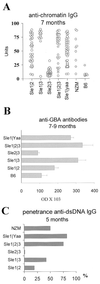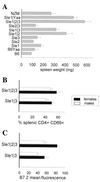Genetic reconstitution of systemic lupus erythematosus immunopathology with polycongenic murine strains
- PMID: 10841565
- PMCID: PMC18697
- DOI: 10.1073/pnas.97.12.6670
Genetic reconstitution of systemic lupus erythematosus immunopathology with polycongenic murine strains
Abstract
We previously produced three congenic strains carrying lupus susceptibility genes (Sle1-Sle3) from the lupus-prone NZM2410 mouse on the C57BL/6 background and characterized their component phenotypes. Sle1 mediates the loss of tolerance to nuclear antigens; Sle2 lowers the activation threshold of B cells; and Sle3 mediates a dysregulation of CD4(+) T cells. We have now created a collection of bi- and tricongenic strains with these intervals and assessed the autoimmune phenotypes they elicit in various combinations. Our results indicate that Sle1 is key for the development of fatal lupus. The combination of Sle1 with Sle2, Sle3, or the BXSB-derived autoimmune accelerating gene yaa results in the development of systemic autoimmunity with variably penetrant severe glomerulonephritis culminating in kidney failure. In contrast, two locus combinations of Sle2, Sle3, and yaa failed to mediate fatal disease. These results indicate that the loss of tolerance to chromatin mediated by Sle1 is essential for disease pathogenesis and identify the pathway occupied by Sle1 as a strategic target for therapeutic intervention in systemic lupus erythematosus. The coexpression of Sle1, Sle2, and Sle3 as a B6-triple congenic results in severe systemic autoimmunity and fully penetrant, fatal glomerulonephritis. These results demonstrate the fulfillment of the genetic equivalent of Koch's postulate, where susceptibility loci in a lupus-prone strain have been identified by a genome scan, isolated and functionally characterized by congenic dissection, and finally shown to mediate full disease expression when recombined in a normal genome.
Figures



References
-
- Kotzin B L, O'Dell J R. In: Samter's Immunologic Diseases. Frank M M, Austen K F, Claman H N, Unanue E R, editors. Brown, Boston: Little; 1995. pp. 667–698.
-
- Harley J B, Moser K L, Gaffney P M, Behrens T W. Curr Opin Immunol. 1998;10:690–696. - PubMed
-
- Gulko P S, Winchester R J. In: Lupus: Molecular and cellular pathogenesis. Kammer G M, Tsokos G C, editors. Totowa, NJ: Humana; 1999. pp. 101–123.
-
- Theofilopoulos A N. In: Systemic Lupus Erythematosus. Lahita R G, editor. New York: Churchill Livingstone; 1993. pp. 121–194.
-
- Vyse T J, Kotzin B L. Annu Rev Immunol. 1998;16:261–292. - PubMed
Publication types
MeSH terms
Substances
Grants and funding
LinkOut - more resources
Full Text Sources
Other Literature Sources
Medical
Molecular Biology Databases
Research Materials

